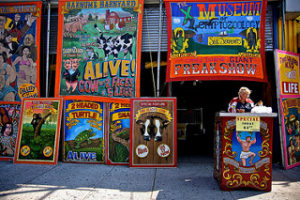 Web 1.0 was the internet before “talkback.” It was static one-directional communication. Whether intentional or not, it was inherently self-centered, presenting the view of the owner of the website. Web 2.0 is the interactive internet where people are invited and encouraged to make their views known.
Web 1.0 was the internet before “talkback.” It was static one-directional communication. Whether intentional or not, it was inherently self-centered, presenting the view of the owner of the website. Web 2.0 is the interactive internet where people are invited and encouraged to make their views known.
I recently drafted a series of statements in an effort to differentiate among sales, audience development, audience engagement, and community engagement. When I finished the first pass at it, I realized that I had formulated it using a traditionalist mental model of arts marketing–kinda Arts 1.0. Here’s what I came up with:
- Sales
- This is what’s happening.
- Buy a ticket.
- Audience Development
- This is what’s happening.
- This seems like a reason you might be interested.
- Buy a ticket.
- Audience Engagement
- This is what’s happening.
- This seems like a reason you might be interested.
- Here’s something we think is worthwhile/relevant to you about it.
- Buy a ticket.
Clearly this is all one-directional communication. While this may be a not-totally-incorrect view of some “arts marketing,” it’s not fair to what could and should be. Realizing this I decided to apply the same thinking to my field of expertise. A good deal of “community engagement” goes like this:
- Community Engagement
- Get a grant
- Find some poor people
- Tell them why what’s happening is good for them
- Be surprised when they don’t show up
A 2.0 version of all of these would emphasize the need for two-way communication. Let’s try this again.
The first three should all be preceded by “Get to know them.” After that, it might look like:
- Sales
- This is what’s happening.
- This is why it’s going to be worth your time and money.*
- Buy a ticket.
- Audience Development
- This is what’s happening.
- This is why it’s going to be worth your time and money.*
- This seems like a reason you might be especially interested.*
- Buy a ticket.
- Audience Engagement
- This is what’s happening.
- This is why it’s going to be worth your time and money.*
- This seems like a reason you might be especially interested.*
- Here’s something that might make this even more worthwhile/relevant to you.*
- Buy a ticket.
*We know this because we listened to what you told us.
And the 2.0 community engagement list would be
- Community Engagement
Step 1- Pleased to meet you.
- Tell me about yourself.
- This is what we do.
Step 2
- If we do [this thing*], will you help us make it better/be successful**?
Step 3***
- Let’s keep in touch.
*Chosen based on what they told you about themselves.
**Funding, community support, ticket sales
***Post-event
The obvious distinction between the first three and community engagement is the final line–Buy a ticket. That’s of critical importance to arts organizations and is the essence of sales, audience development, and audience engagement. Community engagement, while it has “Buy a ticket” (as well as “Contribute now” and “Support arts-friendly public policy”) as a long-term result, is a seed planting effort. That’s another reason relationship maintenance–”Let’s keep in touch”–is so important.
Too much of our industry is operating with an Arts 1.0 mental model. It gets in the way of selling tickets and it makes effective community engagement impossible.
Engage!
Doug
Photo: ![]()
![]() Some rights reserved by presta
Some rights reserved by presta

[…] Arts 1.0 Web 1.0 was the internet before “talkback.” It was static one-directional communication. Whether intentional or not, it was inherently self-centered, presenting the view of the owner of the website. Web 2.0 is the interactive internet … read more AJBlog: Engaging Matters Published 2017-08-29 […]